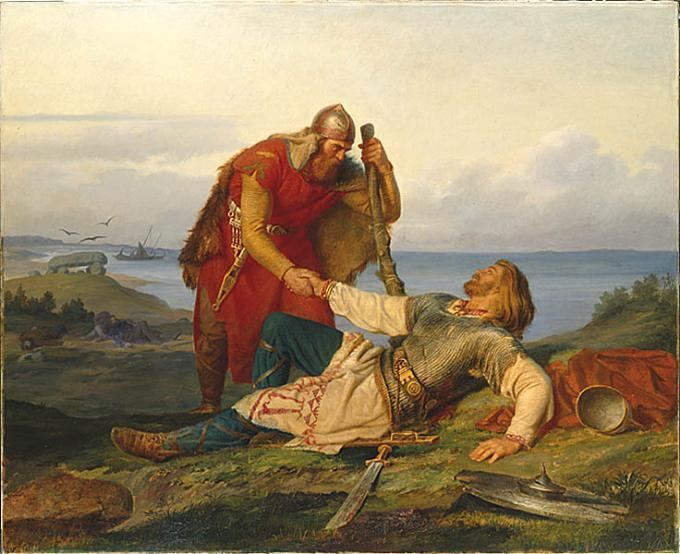 | ||
Blood brother can refer to one of two things: a male related by birth, or two or more men not related by birth who have sworn loyalty to each other. This is in modern times usually done in a ceremony, known as a blood oath, where having each person make a small cut, usually on a finger, hand or the forearm, and then the two cuts are pressed together and bound, the idea being that each person's blood now flows in the other participant's veins. The act may carry a risk due to blood-borne diseases. In modern times, some gangs have also been rumored to make blood pacts. The process usually provides a participant with a heightened symbolic sense of attachment with another participant.
Contents
Scandinavia
Örvar-Oddr's saga contains a notable account of blood brotherhood. The Norwegian warrior Örvar-Oddr felt a desire to test his fighting skills with the renowned Swedish warrior Hjalmar. Thus Örvar-Oddr sailed to Sweden with five ships and met Hjalmar, who had fifteen ships. Hjalmar could not accept such an uneven balance of strength and sent away ten of his own ships so that the forces would be even. The two warriors fought for two days with a lot of blood-letting and poetry, but it was a draw. Finally, they realized that they were equals and decided to become sworn brothers by letting their blood flow under a strand of turf raised by a spear. Then, the strand of turf was put back during oaths and incantations.
In the mythology of northern Europe, Gunther and Högni became the blood brothers of Sigurd when he married their sister Gudrun; in Wagner's Ring Cycle, the same occurs between Gunther and Wagner's version of Sigurd, Siegfried, which is marked by the "Blood Brotherhood Leitmotiv". Additionally, it is briefly stated in Lokasenna that Odin and Loki were once blood brothers.
Scythia
Among the Scythians, the covenantors would allow their blood to drip into a cup; the blood was subsequently mixed with wine and drunk by both participants. Every man was limited to having at most three blood brotherhoods at any time, lest his loyalties be distrusted; as a consequence, blood brotherhood was highly sought after and often preceded by a lengthy period of affiliation and friendship (Lucian, Toxaris). 4th-century BC depictions of two Scythian warriors drinking from a single drinking horn (most notably in a gold appliqué from Kul-Oba) have been associated with the Scythian oath of blood brotherhood.
The Hungarian hajduks had a similar ceremony, though the wine was often replaced with milk so that the blood would be more visible.
East Asia
In Asian cultures, the act and ceremony of becoming blood brothers is generally seen as a tribal relationship, that is, to bring about alliance between tribes. It was practiced for this reason most notably among the Mongols and early Chinese.
Americas
There is some evidence that Native Americans did it to bring about alliance between tribes.
Southeastern Europe
Blood brothers among larger groups were common in ancient Southeastern Europe where, for example, whole companies of soldiers would become one family through the ceremony. It was perhaps most prevalent in the Balkans during the Ottoman era, as it helped the oppressed people to fight the enemy more effectively; blood brotherhoods were common in what is today Albania, Bosnia and Herzegovina, Bulgaria, Croatia, Greece, Montenegro, Serbia, Republic of Macedonia. Christianity also recognized sworn brotherhood in a ceremony (known as Greek: adelphopoiesis, Slavic: pobratimstvo in the Eastern Orthodox churches; known as Latin: ordo ad fratres faciendum in the Roman Catholic church). The tradition of intertwining arms and drinking wine is also believed to be a representation of becoming blood brothers.
Caucasus
Blood brotherhood, highly ritualized and subjected to a strong code, was a common practice in the Caucasus, especially among the mountaineers. Some relics of this tradition survive to this day.
